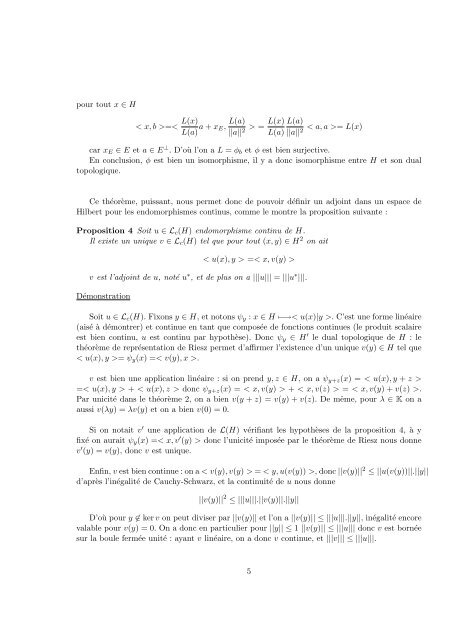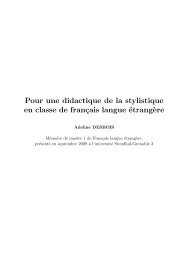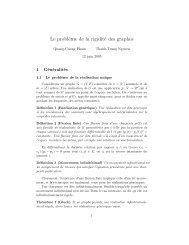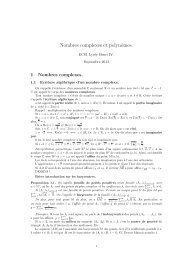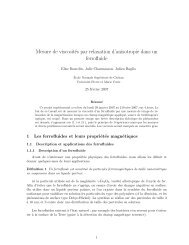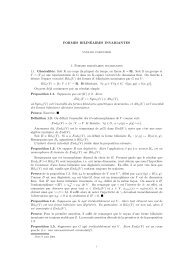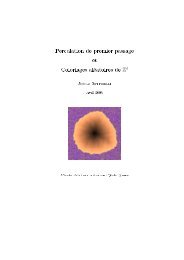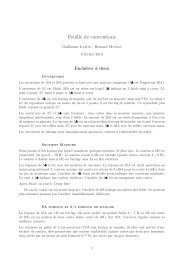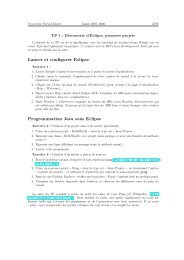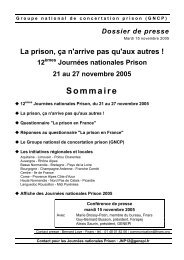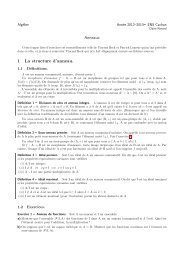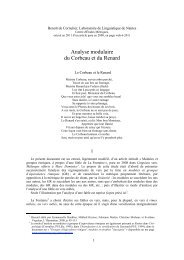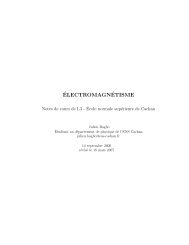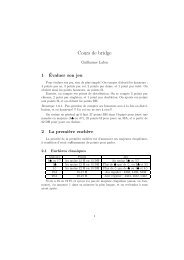Le théorème de représentation de Riesz dans un ... - Normalesup.org
Le théorème de représentation de Riesz dans un ... - Normalesup.org
Le théorème de représentation de Riesz dans un ... - Normalesup.org
You also want an ePaper? Increase the reach of your titles
YUMPU automatically turns print PDFs into web optimized ePapers that Google loves.
pour tout x ∈ H<br />
< x, b >=< L(x) L(a) L(x)<br />
a + xE, > =<br />
L(a) ||a|| 2 L(a)<br />
L(a)<br />
< a, a >= L(x)<br />
||a|| 2<br />
car xE ∈ E et a ∈ E ⊥ . D’où l’on a L = φb et φ est bien surjective.<br />
En conclusion, φ est bien <strong>un</strong> isomorphisme, il y a donc isomorphisme entre H et son dual<br />
topologique.<br />
Ce <strong>théorème</strong>, puissant, nous permet donc <strong>de</strong> pouvoir définir <strong>un</strong> adjoint <strong>dans</strong> <strong>un</strong> espace <strong>de</strong><br />
Hilbert pour les endomorphismes continus, comme le montre la proposition suivante :<br />
Proposition 4 Soit u ∈ Lc(H) endomorphisme continu <strong>de</strong> H.<br />
Il existe <strong>un</strong> <strong>un</strong>ique v ∈ Lc(H) tel que pour tout (x, y) ∈ H 2 on ait<br />
< u(x), y > =< x, v(y) ><br />
v est l’adjoint <strong>de</strong> u, noté u ∗ , et <strong>de</strong> plus on a |||u||| = |||u ∗ |||.<br />
Démonstration<br />
Soit u ∈ Lc(H). Fixons y ∈ H, et notons ψy : x ∈ H ↦−→< u(x)|y >. C’est <strong>un</strong>e forme linéaire<br />
(aisé à démontrer) et continue en tant que composée <strong>de</strong> fonctions continues (le produit scalaire<br />
est bien continu, u est continu par hypothèse). Donc ψy ∈ H ′ le dual topologique <strong>de</strong> H : le<br />
<strong>théorème</strong> <strong>de</strong> <strong>représentation</strong> <strong>de</strong> <strong>Riesz</strong> permet d’affirmer l’existence d’<strong>un</strong> <strong>un</strong>ique v(y) ∈ H tel que<br />
< u(x), y >= ψy(x) =< v(y), x >.<br />
v est bien <strong>un</strong>e application linéaire : si on prend y, z ∈ H, on a ψy+z(x) = < u(x), y + z ><br />
=< u(x), y > + < u(x), z > donc ψy+z(x) = < x, v(y) > + < x, v(z) > = < x, v(y) + v(z) >.<br />
Par <strong>un</strong>icité <strong>dans</strong> le <strong>théorème</strong> 2, on a bien v(y + z) = v(y) + v(z). De même, pour λ ∈ K on a<br />
aussi v(λy) = λv(y) et on a bien v(0) = 0.<br />
Si on notait v ′ <strong>un</strong>e application <strong>de</strong> L(H) vérifiant les hypothèses <strong>de</strong> la proposition 4, à y<br />
fixé on aurait ψy(x) =< x, v ′ (y) > donc l’<strong>un</strong>icité imposée par le <strong>théorème</strong> <strong>de</strong> <strong>Riesz</strong> nous donne<br />
v ′ (y) = v(y), donc v est <strong>un</strong>ique.<br />
Enfin, v est bien continue : on a < v(y), v(y) > = < y, u(v(y)) >, donc ||v(y)|| 2 ≤ ||u(v(y))||.||y||<br />
d’après l’inégalité <strong>de</strong> Cauchy-Schwarz, et la continuité <strong>de</strong> u nous donne<br />
||v(y)|| 2 ≤ |||u|||.||v(y)||.||y||<br />
D’où pour y ∈ ker v on peut diviser par ||v(y)|| et l’on a ||v(y)|| ≤ |||u|||.||y||, inégalité encore<br />
valable pour v(y) = 0. On a donc en particulier pour ||y|| ≤ 1 ||v(y)|| ≤ |||u||| donc v est bornée<br />
sur la boule fermée <strong>un</strong>ité : ayant v linéaire, on a donc v continue, et |||v||| ≤ |||u|||.<br />
5


